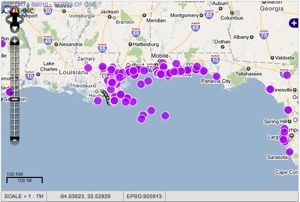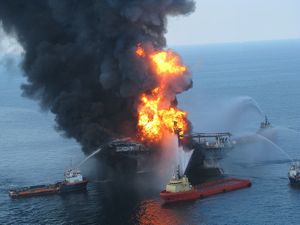Oil in the Air
Air Date: Week of July 23, 2010

Oil Spill Crisis Map. (Image: Louisiana Bucket Brigade)
The oil in the Gulf isn’t just damaging the ocean. It’s also compromising the air. The EPA has been widely monitoring air quality along the Gulf coast since the spill began, but a local advocacy group, the Louisiana Bucket Brigade, says it’s not enough. Host Jeff Young talks with Anne Rolfes, director of the Bucket Brigade, about what she thinks the EPA is missing.
Transcript
YOUNG: It’s not just the water that has people worried on the Gulf coast. Air quality data recently released by the government show high levels of some hydrocarbons downwind of the blown-out well. EPA has been monitoring air quality along the Gulf coast widely, but an advocacy group, the Louisiana Bucket Brigade, analyzed the EPA data, and found some shortcomings. Anne Rolfes directs the Louisiana Bucket Brigade.
ROLFES: What we found is that there are tremendous gaps in the EPA samplings. While the EPA does have a monitoring network, there are a lot of problems in this area including terrible odors, and health complaints that are not being accounted for by those monitors.
YOUNG: What do we know from the monitoring we have about the level of chemical exposure that people might be suffering?
ROLFES: The EPA data show hydrogen sulfide to be an area of concern, there have also been repeated benzene readings when they have gone out and sampled for it.

(Photo: United States Coast Guard)
YOUNG: And benzene, that’s a carcinogen, isn’t it?
ROLFES: Yeah benzene is known to cause leukemia; it’s a class A carcinogen. Now we’re not saying that everybody who’s exposed is going to get cancer tomorrow, but we are raising a flag about ongoing prolonged exposure in the Gulf Coast.
YOUNG: So, how do you know that there are gaps in what EPA is telling you? What do you have to point at and say, “Hey you’re missing things here!”
ROLFES: We have created an oil spill crisis map which is a very simple way for an ordinary person to report that they smelled something terrible, that maybe their head hurt, or their child got asthma when the child has never had asthma before.
These reports show up on a map and they’re either orange dots or blue dots, and we can pair the location of those dots with the location of the EPA monitors. And what we’re finding out is that there are very few dots that represent EPA monitors.

Oil Spill Crisis Map. (Image: Louisiana Bucket Brigade)
Whereas there are hundreds of dots that represent health and odor complaints, and a lot of those complaints are not in areas where EPA has monitors. They cannot be everywhere at one time, and so we think that the best thing to do is to arm ordinary community members with the tools that we need to go out and take samples for ourselves.
YOUNG: So you want EPA to what, hire on local folks to do some of the air monitoring?
ROLFES: There is a whole class of people here who are out of work: fishermen, shrimpers, oystermen, anybody who had anything to do with the seafood industry. And they are also the perfect people to now going forward monitor the environment. If you think about it who knows the marshes and the bayous better than anybody.
We’re just living down here, we’re guinea pigs in a living laboratory. And all we’re saying here is, improve the data collection so that we can get a little bit more knowledge for this laboratory of ours.
YOUNG: Anne Rolfes with the Louisiana Bucket Brigade, thank you very much.
ROLFES: Thanks a lot, Jeff. We appreciate y'alls interest.
Links
Visit the Louisiana Bucket Brigade website
Living on Earth wants to hear from you!
Living on Earth
62 Calef Highway, Suite 212
Lee, NH 03861
Telephone: 617-287-4121
E-mail: comments@loe.org
Newsletter [Click here]
Donate to Living on Earth!
Living on Earth is an independent media program and relies entirely on contributions from listeners and institutions supporting public service. Please donate now to preserve an independent environmental voice.
NewsletterLiving on Earth offers a weekly delivery of the show's rundown to your mailbox. Sign up for our newsletter today!
 Sailors For The Sea: Be the change you want to sea.
Sailors For The Sea: Be the change you want to sea.
 The Grantham Foundation for the Protection of the Environment: Committed to protecting and improving the health of the global environment.
The Grantham Foundation for the Protection of the Environment: Committed to protecting and improving the health of the global environment.
 Contribute to Living on Earth and receive, as our gift to you, an archival print of one of Mark Seth Lender's extraordinary wildlife photographs. Follow the link to see Mark's current collection of photographs.
Contribute to Living on Earth and receive, as our gift to you, an archival print of one of Mark Seth Lender's extraordinary wildlife photographs. Follow the link to see Mark's current collection of photographs.
 Buy a signed copy of Mark Seth Lender's book Smeagull the Seagull & support Living on Earth
Buy a signed copy of Mark Seth Lender's book Smeagull the Seagull & support Living on Earth

